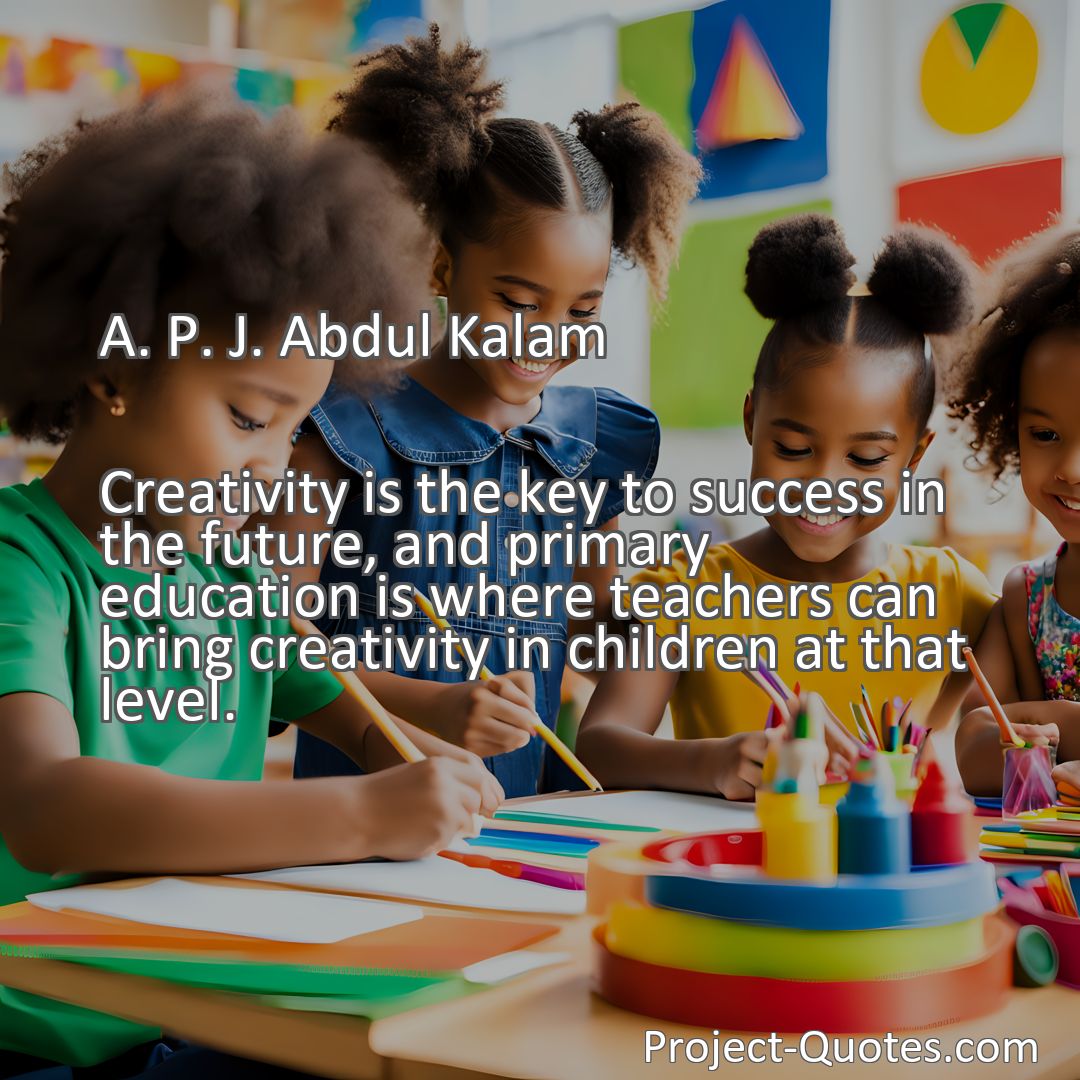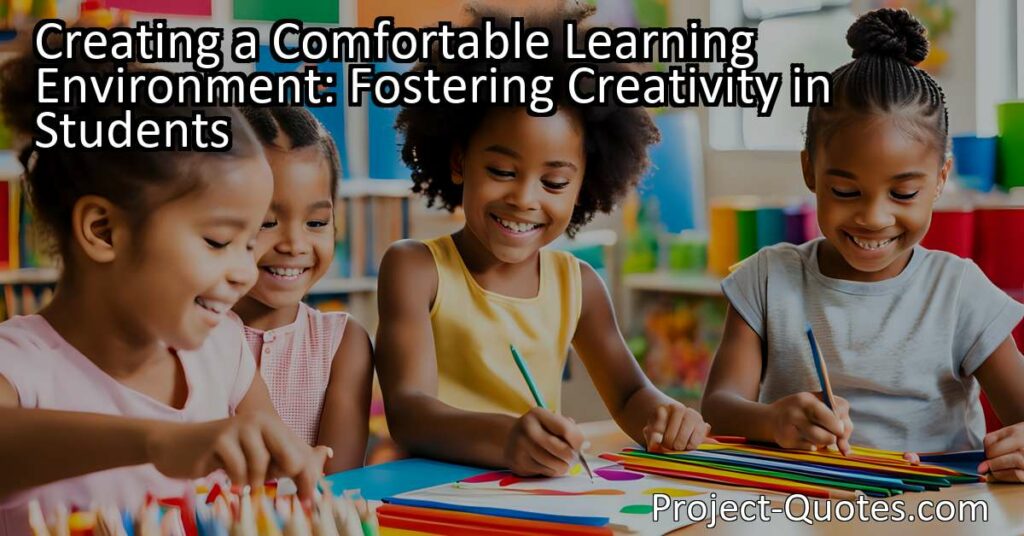Creativity is the key to success in the future, and primary education is where teachers can bring creativity in children at that level.
A. P. J. Abdul Kalam
In order to foster creativity in students, it is important for teachers to create a comfortable learning environment where students feel comfortable taking risks. By eliminating the fear of judgment and embracing a growth mindset, students can gain confidence and resilience to explore their creative abilities freely.
Table of Contents
- 1 Creativity is the key to success in the future, and primary education is where teachers can bring creativity in children at that level.
- 2 A. P. J. Abdul Kalam
- 3 Meaning of Quote – Creativity is the key to success in the future, and primary education is where teachers can bring creativity in children at that level.
- 4 Freely Shareable Quote Image
- 5 Related
Meaning of Quote – Creativity is the key to success in the future, and primary education is where teachers can bring creativity in children at that level.
In the words of the renowned scientist and former President of India, A. P. J. Abdul Kalam, “Creativity is the key to success in the future, and primary education is where teachers can bring creativity in children at that level.” These profound words highlight the importance of fostering creativity in young minds, especially during the crucial years of primary education.
When we think of creativity, we often associate it with art, music, or imaginative play. However, creativity goes far beyond these traditional realms. It is the ability to think outside the box, problem-solve, and approach challenges with innovative ideas. In an ever-changing world, where jobs and industries rapidly evolve, it is this creative mindset that will empower children to thrive and succeed.
Primary education plays a fundamental role in shaping a child’s cognitive, emotional, and social development. It is during this stage that children are at their most receptive, curious, and imaginative selves. Therefore, it is imperative for educators to capitalize on this innate creativity and provide an environment that nurtures and encourages it.
One of the ways teachers can bring creativity into the lives of young learners is through the integration of art and self-expression in the curriculum. Art allows children to explore their emotions, express their thoughts, and develop their unique voices. It encourages divergent thinking, where there is no one correct answer, but rather a multitude of possibilities. By incorporating art activities, such as painting, drawing, or sculpting, teachers provide a platform for children to unleash their creative potential.
Moreover, the inclusion of music and movement in classrooms can also stimulate creativity. Music has a powerful effect on the brain, enhancing cognitive abilities and aiding in emotional expression. When children engage in musical activities, such as singing, playing instruments, or composing their own songs, they activate various regions of their brains, fostering creativity, and promoting a holistic development.
In addition to artistic expression, it is essential for teachers to introduce problem-solving activities that challenge children to think critically and creatively. These activities can range from puzzles, riddles, and brainteasers to open-ended projects that prompt students to find innovative solutions. By engaging in such activities, children learn to think beyond the obvious, analyze complex problems, and apply their knowledge and imaginations to devise unique strategies.
Furthermore, teachers can foster creativity by encouraging divergent thinking in the classroom. Divergent thinking is the ability to generate multiple ideas, solutions, or possibilities in response to a given situation. It requires flexibility, adaptability, and a willingness to explore uncharted territories. Rather than focusing solely on finding the “right” answer, educators should value and praise students’ ability to think differently. This can be achieved through classroom discussions, brainstorming sessions, and group projects that promote collaboration and diverse perspectives.
To truly foster creativity in children, it is crucial for educators to create a safe and supportive learning environment. In such an environment, students feel comfortable taking risks, making mistakes, and learning from them. By eliminating the fear of judgment and embracing a growth mindset, teachers can instill a sense of confidence and resilience in children, allowing them to explore their creative abilities freely.
Moreover, technology can serve as a valuable tool to enhance creativity in the primary classroom. With the advent of digital tools and resources, students can engage in a wide range of creative activities, such as coding, multimedia presentations, and virtual art installations. By incorporating technology in education, teachers not only make the learning process more interactive and engaging but also equip students with digital literacy skills that are vital in today’s rapidly advancing world.
It is worth noting that creativity should not be limited to specific subjects or areas of study. Rather, it should be integrated across the curriculum, spanning various disciplines. For instance, in English language arts, teachers can encourage students to write imaginative stories, poems, or scripts. In science, children can engage in experiments and projects that require them to think creatively and critically. By intertwining creativity with academic subjects, teachers demonstrate the interconnectedness of knowledge and foster a holistic approach to learning.
Furthermore, primary education should also emphasize the importance of curiosity and exploration. Encouraging children to ask questions, seek answers, and delve deeper into their areas of interest fosters a sense of intellectual curiosity that is essential for creativity to thrive. Teachers can design inquiry-based lessons that encourage students to explore their surroundings, conduct experiments, and develop a sense of wonder and awe for the world.
In conclusion, the words of A. P. J. Abdul Kalam echo the significance of fostering creativity in primary education. By embracing creativity, teachers empower children with the necessary skills to succeed in the future. It is through artistic expression, problem-solving activities, divergent thinking, a supportive learning environment, technological integration, and a curriculum that values curiosity that teachers can unlock the vast creative potential of young minds. Let us remember that the key to success lies in nurturing the creativity of our children, enabling them to become innovative thinkers, problem-solvers, and lifelong learners.
I hope this quote inspired image brings you hope and peace. Share it with someone who needs it today!


